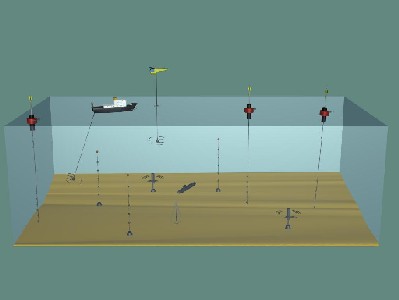|
You are not Logged in! Log in to check your messages. |

|
|
Check todays hot topics |
Web2Project Sign in
Project PHITOM

Probabilistic High-Frequency Ocean Tomography for Underwater Communications and Navigation (PHITOM)
PHITOM aims at developing and applying techniques of ocean acoustic tomography (OAT) to the HF signals used in digital communications incorporating into the receiver some awareness of the environment and the spatial configuration of the acoustic link that is almo current underwater modems. Having this capability built into the receiver is very appealing for a number of reasons. This project is financed by the PTDC programme, with 172 kEuro for 3 years. Starting date: 01-12-2007. Duration 36 months. Contract: PTDC/EEA-TEL/71263/2006
Abstract:
Environmental surveying and military applications such as submarine detection have driven much of the research effort on underwater acoustics over the last decades. Although absorption effectively limits high-frequency (HF) underwater acoustics to relatively short-range scenarios, it has enjoyed a continued interest for special applications. Short range applications based on HF benefit from high spatial resolution, wide bandwidth, small size and low cost. Applications of current interest include underwater communications with autonomous underwater vehicles, wireless underwater sampling and monitoring networks, mine hunting, torpedo homing, and seafloor mapping. In particular, current underwater modems employ generic architectures originally developed for wireless terrestrial communications, with small modifications that account for specificities of underwater propagation. While this approach works well in many cases of practical interest, it is not uncommon for an acoustic link to fail by poorly understood reasons (usually explained a posteriori by hand waving arguments). Acoustic modeling at low frequencies (LF) up to about 2 kHz, say, and surveying technologies have become sufficiently precise to currently enable applications such as model-based source tracking using matched-field processing and tomography/focalization to determine environmental parameters. HF acoustic modeling, which requires that fundamental uncertainties about the environment be accounted for using appropriate statistical tools, is less developed than at LF. This project aims to develop and apply techniques of ocean acoustic tomography (OAT) to the HF signals used in digital communications, incorporating into the receiver some awareness of the environment and the spatial configuration of the acoustic link that is almost totally lacking in current underwater modems. Having this capability built into the receiver is very appealing for a number of reasons. (i) It may provide a clearer picture of the difficulties involved in a given spatial configuration of the acoustic link. Hopefully this could serve as a basis for tuning the receiver architecture (e.g., the filters used in equalization) to a particular ensemble of expected channel impulse responses, hence reducing the number of parameters and improving the robustness in their adaptation. (ii) It could supply useful oceanographic information about the environment at no extra cost. In line with the philosophy of field calibration (see Section 8.3), these estimates could be used to calculate initial guesses to be used in dedicated LF OAT experiments. (iii) It provides useful localization information to be incorporated into the navigation system of a vehicle in which the receiver is mounted. In a communications context, and assuming integration with navigation systems at both channel endpoints, it seems reasonable to admit that basic side information such as receiver and transmitter velocities and coarse position estimates may be available. These may be obtained at the receiver by interrogating its local navigation system, and by decoding a short dedicated message (possibly transmitted using a low-speed but robust modulation) containing similar data generated at the transmitter. Feeding back refined estimates to the local navigation system would establish a feedback loop integrating navigation and communications that has often been envisaged in the technical literature on underwater robotics, but which has not been clearly accomplished so far. Realistically, the proposed estimation will require some side information regarding water depth, velocity profile and the type of seafloor. Given the low penetration of HF sound in sediments, the parameter space to be searched will possibly have lower dimensionality than in LF OAT. Moreover, the proposed environment matching criterion will be based on ray travel times, for which the velocity profile may be discretized fairly roughly. The inverse problem is cast in a Bayesian inference framework that naturally integrates a priori information about environment parameters and their uncertainties, and lends itself to time recursive estimation by sequential Bayesian methods. The methods and algorithms to be developed will be tested with data collected at sea, and integrated to form a coherent tool for HF OAT and communications. Still, given the large computational load associated with most algorithms in (LF) OAT and simulation-based Bayesian inference, the goal at this stage is not to attain real-time operation but rather to demonstrate the concept that useful data can be extracted from a communications system besides the actual digital messages. In our vision for the future, this type of system would play the role of a master environment monitor, supplying local real-time communication systems with physical side information. Receiver design techniques for incorporating this information are beyond the scope of this project.
Objectives:
 Develop a framework for extracting
environmental and navigation data as a byproduct of underwater communications. This information
is intended for improved localization and to guide the design of filters for digital receivers.
Develop a framework for extracting
environmental and navigation data as a byproduct of underwater communications. This information
is intended for improved localization and to guide the design of filters for digital receivers. Extend methods for inverse problems in
geoacoustics and oceanography to the high-frequency band used in communications. Bayesian inference
is adopted to incorporate prior knowledge and enable tracking. Ray acoustics are used for modeling.
Extend methods for inverse problems in
geoacoustics and oceanography to the high-frequency band used in communications. Bayesian inference
is adopted to incorporate prior knowledge and enable tracking. Ray acoustics are used for modeling. Demonstrate the effectiveness of this approach
using data collected at sea.
Demonstrate the effectiveness of this approach
using data collected at sea. Develop an integrated software prototype.
Develop an integrated software prototype.


